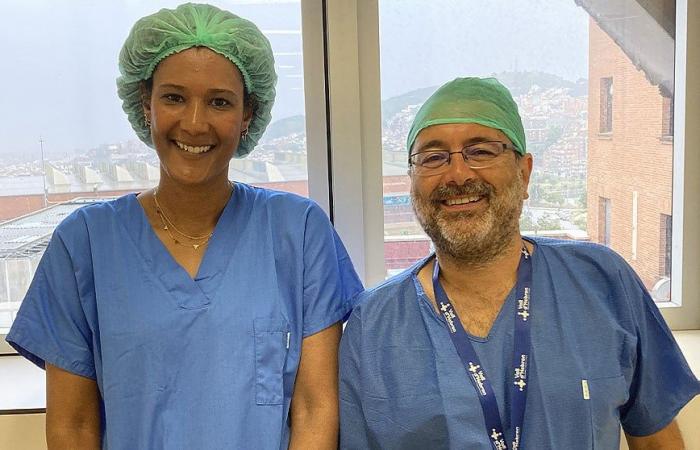The robotic surgery has allowed us to go beyond even the famous novel ‘20,000 Leagues Under the Sea‘, allowing a leap in quality within the Pediatric Urology and get the specialists to immerse themselves until “operate from within the patient, working in very small spaces and being able to perform complex sutures.” One of the main reference centers in this type of approach is the Vall d’Hebron Hospitalwhich has achieved a total of 120 surgeries of these characteristics. Marino Asensio, head of the Section of Pediatric Urology and Kidney Transplantation; and Gloria Royoassociate surgeon, represent the present and future of the Service, sharing the same vision of the future: “In Spain There are plenty of reference centers, although the problem lies in their distribution. Transferring health responsibilities to each community is detrimental to patients, so it is necessary create reference centers at the state level.”
The fact of having performed more than 100 pediatric urological surgeries means for Royo “that the pediatric program formed by nurses, anesthetists and pediatric surgeons It is working and improving thanks to robotic surgery. The program is very established.” The specialist recalls that the Catalan center is the only hospital in Spain that “has been carrying out 15 years operations with pediatric patients from two years until 17so we are a reference to be able to offer this Service publicly to pediatric patients.”
Asensio assures that the future of Pediatric Urology involves ensuring generational change. |
Robotic surgery penetrated the Pediatric Urology and Kidney Transplant Service once Asensio achieved the necessary degree to be able to operate with a robot. The specialist himself remembers that “this new era began with a ovarian surgery and little by little new indications were added until today.”
How the robot works and the role of robotic arms
In order to carry out an operation linked to malformations of the urinary system of the pediatric populationRoyo highlights that it is necessary “a specialist who is in charge of the console, in addition to having an assistant, a nurse who knows the robot operation and that can solve or provide solutions to surgical problems. Finally, the anesthetist is key to performing a complete surgery at the pediatric level. “This is very important training at a multidisciplinary level.”
=”600″ height=”240″ layout=”responsive” alt=”AMP”> One of the moments during the surgery performed at the Vall d’Hebron Hospital. |
The incorporation of robotic arms when performing this type of surgery has completely revolutionized the field of Pediatric Urology, as Asensio highlights: “For the first time, the patient is being operated on from the inside with forceps handled by a robot and the specialist goes where he is interested”. The expert compares this type of surgery with the traditional one, in which “a big wound and then mobilize the parts to get them to where you want to go. With robotic surgery the opposite is intended and it is possible to generate much less pain in the postoperative period by not having a wound, in addition to a very subtle control of all instruments”.
The story of Ian, a patient with stenosis
One of the last patients that the team led by Asensio has operated on is Ianan eight-year-old boy who suffered a renal colic during a trip to the Argentine jungle, suffering from stenosis. Royo states that “his kidney was suffering from an accumulation of urine, but until the renal colic there were no signs.”
=”600″ height=”240″ layout=”responsive” alt=”AMP”> The mechanical arms of the surgical robot in full action. |
After being operated on in other centers, Ian finally arrived at Vall d’Hebron, where he managed to “access the affected area with small incisions of less than five millimeters very precisely, avoiding complications and facilitating early recovery.”
The need for reference centers at the state level
Royo analyzes the role and advantages of having robotic arms. |
For the head of Section, at the Spanish level there is sufficient training to be able to attend to all these pediatric patients, although the problem is “the distribution of reference centers. The National Health System (SNS) is transferred to the autonomous communities and each one tries to solve their problems. This situation is detrimental to the care of patients, who would benefit from reference centers at the state level.”
The Pediatric Urology and Kidney Transplant Service continues to add new objectives for the future, and Asensio focuses on two different pathsonce he decides to retire: “It is essential to have a good generational change and prepare the people who come, who are extraordinary, to be able to perform increasingly complex surgeries.”
=”600″ height=”240″ layout=”responsive” alt=”AMP”> Marino Asensio, head of the Pediatric Urology and Kidney Transplant Section, using the surgical robot during the operation. |
Although it may contain statements, data or notes from health institutions or professionals, the information contained in Medical Writing is edited and prepared by journalists. We recommend the reader that any health-related questions be consulted with a healthcare professional.






